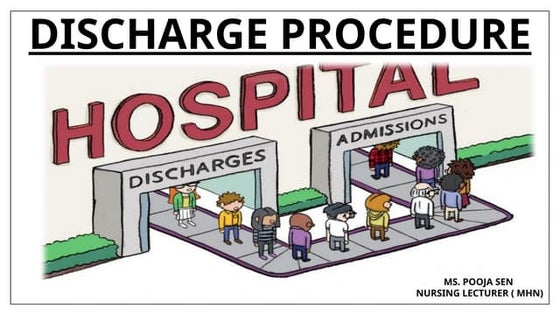Teaching in the age of disaster slides
0 likes27 views
In the face of climate change, environmental injustice, gun violence, pandemics, mass migrations, and other challenges, liberal arts education is more essential than ever. How might liberal arts faculty prepare students for the Age of Disaster? Dr. Madsen suggests the answer lies within a diverse constellation of practices, among them developing studentsŌĆÖ maker competencies, committing even more deeply to interdisciplinarity, designing for inclusivity in courses and programs, and rooting out subtle and not-so-subtle departmental and institutional white supremacies.
1 of 24
Download to read offline
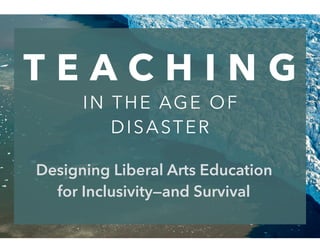























Recommended
Intercultural Competence



Intercultural CompetenceAbdul Aziz Popal
╠²
This document discusses intercultural competence and cultural orientations in the workplace. It introduces the Intercultural Development Continuum, which ranges from a monocultural to an intercultural mindset. A monocultural mindset is characterized by denial, defense, and superiority over other cultures. An intercultural mindset involves deep exploration of differences, understanding other perspectives, and adapting one's behaviors. The document provides examples to assess whether a scenario demonstrates a monocultural, transitional, or intercultural orientation. It concludes that developing intercultural awareness allows for diversity to be understood and valued.Diversity and Inclusion



Diversity and InclusionRobert Travis
╠²
The document discusses diversity, inclusion, and cultural differences in organizations. It provides definitions of key terms like diversity and inclusion and outlines various laws related to equal employment opportunities. The document also discusses approaches to diversity like intervention theory, creating diversity and inclusion initiatives, and focusing on commonalities rather than differences to capitalize on human diversity for organizational success. Challenges and strategies for addressing cultural differences are also presented.Six ways to teach culture effectively



Six ways to teach culture effectivelyJoe McVeigh
╠²
The document discusses six effective ways to teach culture to students. It begins by having students articulate their own definitions of culture. It then explores the differences between spoken and written language. Next, it examines kinesics, movement, and gestures in non-verbal communication. It also recognizes the causes and stages of culture shock. Further, it discusses ways to counter the effects of culture shock. Finally, it identifies cultures as either individualistic or collectivistic.Cultural awareness training



Cultural awareness trainingYolanda P Williams
╠²
This document outlines an original training program on embracing cultural diversity. It includes a needs assessment of both the person and task to determine what needs to be learned. The training objectives are to promote development, adjustment, and promotion. The training will be employer initiated, onsite, face-to-face, and facilitated with specific dates and times. A cultural anthropologist will be the proposed instructor, and training materials will include workbooks, videos, and exercises. The training will be evaluated through pre-tests, post-tests, and a six month follow up survey.Call for submissions spring 2015



Call for submissions spring 2015decolonization
╠²
The journal Decolonization: Indigeneity, Education & Society is calling for submissions for an open-themed issue to be published in Spring 2015 on the topics of decolonization. They are seeking articles that center decolonization and further discussions around decolonial possibilities. Possible themes for submissions include decolonial, Indigenous or Afrofuturities; intersections of antiblackness and settler colonialism; and decolonizing colonial pedagogies. Submissions must be received by November 10, 2014 and will go through a double-blind peer review process.Diversity a lived experience by Suzanne Alleyne



Diversity a lived experience by Suzanne AlleyneVictoria Durrer
╠²
Part of Seminar 3, exploring intercultural relations in arts and cultural management higher education, for an AHRC funded research network (www.managingculture.net)Challenging the March for Science



Challenging the March for ScienceZuleyka Zevallos
╠²
The document discusses challenges to diversity, equity, inclusion, accessibility, and intersectionality in the planning and promotion of the March for Science in 2017. It notes that equity and diversity were afterthoughts in the initial planning which was done primarily on social media without experience in social movement organization. This led to undermining of women and people of color, ignoring of disabled researchers, and erasing of LGBTQIA scientists. It provides questions to guide more inclusive event planning by embracing diversity in leadership, decision-making, communication, and addressing the specific barriers faced by marginalized groups.Alternative education presentation



Alternative education presentationAnishaRazzaq
╠²
This document discusses language, representation, and their significance in education according to several thinkers. It examines how the language we speak shapes our thinking and worldviews. Educators are encouraged to recognize how certain languages are marginalized in schools while others are promoted without consideration for students' cultural backgrounds and histories. The document also reflects on the author's personal experiences with issues of representation, language, and culture in educational settings.Global education



Global educationMohammed Fawaz
╠²
The words used and our interpretation of images and statistics are an insight into our perspective or bias ŌĆō our view of the world. Bias influences our attitudes and behaviours towards other people, places and issues. Our experiences, gender, age, class, religion and values all affect our bias. People who are passionate about an issue will generally be quite overt about their bias. People who want to promote a particular point of view may be less overt and more subtle in their use of words and images.
Global education aims to assist students to recognise bias in written and visual texts, consider different points of view and make judgements about how bias can lead to discrimination and inequality.Multi cultural class in a second language adquisition



Multi cultural class in a second language adquisitionKelly Ferny
╠²
Respect, freedom, justice, opportunity and equality, that is multiculturalism and we as teachers we have such a big challenge when we are faced in a multi-cultural class.Cultural changes final



Cultural changes finalDannilyn Manayan
╠²
Multiculturalism is a theory about the foundations of culture rather than just including cultural ideas. It is a comprehensive response to cultural and ethnic diversity with educational, linguistic, economic, and social components and institutional mechanisms. Multiculturalism emphasizes the unique characteristics of different cultures, especially how they relate to one another within a nation. It is a model promoted by UNESCO for democratic policy responses to cultural diversity.343 week 1



343 week 1lisyaseloni
╠²
This document outlines the syllabus for an English course on cross-cultural issues in teaching English as a second language. The course will examine cross-cultural practices and perspectives in TESOL and help students develop a culturally sensitive approach to language teaching. Topics will include language ideologies, multilingualism, and addressing issues of culture, power, and representation in the classroom.Navigating the Labyrinth of Constant Change



Navigating the Labyrinth of Constant ChangeNational Resource Center for Paraprofessionals
╠²
The document summarizes the agenda and content of a national para-professional conference held in 2015 in Hartford, Connecticut. The conference was hosted by Dr. Ashleigh Molloy, president of TransEd Institute, and focused on helping para-professionals navigate constant change, understand 21st century expectations, increase cultural competency, and understand generational differences among students and parents. The agenda included sessions on these topics as well as activities, a presentation on neurodiversity, and a closing message about empowering para-professionals.British council 2013 presentation we act



British council 2013 presentation we actDr. Jorge Nelson
╠²
Dr. Jorge Nelson invites all teachers to observe how leadership can support innovative teaching methods focused on five core competencies: worldview, emotional intelligence, balanced academics, creativity, and technology. Participants will learn about and practice current teaching trends presented by educational leaders. The document discusses each of the five competencies in depth and how they can be incorporated into project-based learning and developing lifelong learners.Teaching in the arts through partnerships and collaboration: constructive ten...



Teaching in the arts through partnerships and collaboration: constructive ten...Graham Jeffery
╠²
║▌║▌▀Żs from a seminar given at the School of Education, University of Exeter, October 2008. Exploring the issues in developing and sustaining artist-teacher partnerships.Types of Teachers



Types of TeachersCentral Connecticut State University
╠²
The document discusses different types of teaching and education. It outlines six types of teachers: top-down/transmitter, technician/robotic, director/conductor, coach, creative/artist, and community explorer. It also discusses three types of education: traditional, liberal/progressive, and transformative. Transformative education is presented as existing at the nexus of human rights, sustainability, and imagination. It is described as being community-centric and focused on supporting students to enact social and ecological democracy. The document suggests that transformative teaching practices best support all students, especially those who have been traditionally marginalized.ON (DE)COLONIALITY-CURRICULUM, WITHIN AND BEYOND THE WEST.pptx



ON (DE)COLONIALITY-CURRICULUM, WITHIN AND BEYOND THE WEST.pptxUniversity of Turbat
╠²
Colonialism a Glance
ŌĆó European colonialism period started on the 15th century
ŌĆó When various European nations explored, conquered, settled, and exploited large areas of the world
ŌĆó European colonizing countries followed policies of Mercantilism
ŌĆó Aim to strengthen the home-country economy, so agreements usually restricted the colony to trading only with the metropole (mother country)
ŌĆó Christian missionaries were active in practically all of the European-controlled colonies because the metropoles were Christian.
ŌĆó World War II colonial powers were forced to retreat between 1945 and 1975, when nearly all colonies gained independence, entering into changed colonial, so called postcolonial and neocolonialist relations.
Phases of Colonialism
ŌĆó Denial and Withdrawal
ŌĆó Destruction/Eradication of all Physical Symbols of Indigenous Culture
ŌĆó Surface Accommodation/Tokenism
ŌĆó Denigration/Belittlement
ŌĆó Transformation/Exploitation
Decolonization
ŌĆó Decolonization is the process of becoming free of colonial status and achieving state hood Between WWI and WWII, movements for independence begun in earnest in Africa and Asia. Dominance of colonial powers seemed at odds with Allied goals in WWII. Call for national self-determination -fight for independence. Empires reluctant to let colonies go.
De-colonizing Education
ŌĆó De-colonialism of Education is a beacon in the struggle against epistemicide and the colonialities of being, power, and knowledge.
ŌĆó It attempts to bring to the fore an analysis that focuses on non-Western/non-Eurocentric epistemological frameworks.
ŌĆó the creation of knowledge, innovation and development in all fields of science and technology, including indigenous knowledge and thereby to contribute to the improvement of the quality of life of all the people of the Republic.
What does De-Colonization look like?
ŌĆó Restores Indigenous worldviews
ŌĆó ŌĆ»Restores culture and traditional ways
ŌĆó ŌĆ»Values and revitalizes Indigenous knowledge and ways of knowing, doing and being
ŌĆó Dismantles structures that perpetuate status quo
ŌĆó Shifts cultural perceptions and power dynamics
ŌĆó ŌĆ»Advances interests of Indigenous peoples by transforming what is important in settler societies
What does De-Colonization look like?
ŌĆó Restores Indigenous worldviews
ŌĆó ŌĆ»Restores culture and traditional ways
ŌĆó ŌĆ»Values and revitalizes Indigenous knowledge and ways of knowing, doing and being
ŌĆó Dismantles structures that perpetuate status quo
ŌĆó Shifts cultural perceptions and power dynamics
ŌĆó ŌĆ»Advances interests of Indigenous peoples by transforming what is important in settler societies
Why should we De-colonize?
ŌĆó ŌĆ£For more than a century, Indigenous students have been part of a forced assimilation plan. their heritage and knowledge rejected and suppressed, and ignored by the education systemŌĆØ (Battiste et al, 2002)
Benefits of De-colonizing of Education
ŌĆó Indigenous students see their culture in the curriculum and feel included and important
ŌĆó Non-Indigenous studentsLouaize pres sjur bergan



Louaize pres sjur berganIAU_Past_Conferences
╠²
It argues that higher education should go beyond just imparting knowledge and focus on developing understanding, abilities, and attitudes in students. Specifically, it says higher education should help foster intercultural dialogue and competencies for dialogue across disciplines, communities, and societies. The document stresses that higher education needs to not only train subject specialists but also educate intellectuals who can consider issues from multiple perspectives with cultural awareness and sensitivity.Jan newcollaradopresentationpowerpoint



Jan newcollaradopresentationpowerpointDr. Bonnie Mozer
╠²
This document outlines a presentation on culturally relevant S.T.E.A.M. instruction strategies. The objectives are to engage participants in culturally relevant activities that model powerful S.T.E.A.M. instruction and provide a conceptual framework for teaching underrepresented students. The presentation focuses on integrating science, technology, engineering, art, and math with culturally responsive techniques. It explores strategies that empower students intellectually and socially, use students' culture as a learning tool, and provide leadership opportunities through literature and social justice themes. Participants will experience sample culturally relevant activities and discuss how to apply these strategies in their own teaching.Incorporating world heritages and cultures into thematic units for TEYL



Incorporating world heritages and cultures into thematic units for TEYLChaouki M'kaddem
╠²
TEFL should not be limited to the teaching of linguistic skills and the culture of the target language. It should rather highlight cultural diversity to prepare young people for a multicultural world. Exposure to different cultures at an early age leaves almost no room for stereotypes.
Diversity and culture flint 2014



Diversity and culture flint 2014Lori Flint
╠²
This document discusses culturally responsive teaching and multicultural education. It defines culturally responsive teaching as using students' cultural experiences to teach them more effectively. The goals of multicultural education are listed as developing multicultural knowledge, educational equity, and teaching with awareness of how factors like culture, race, gender and SES impact learning. The document provides examples of how to design culturally relevant curriculum, develop cross-cultural communication skills, integrate student learning styles, and create an inclusive classroom environment.Post-Modernism in Education .pptx



Post-Modernism in Education .pptxIan Mark Lloyd L. Santisas
╠²
Postmodern perspectives bring to education an openness to diversity and complexity that moves beyond a critique of narrow scientific knowledge.Globalisation and education innovation in the classroom cc project local gl...



Globalisation and education innovation in the classroom cc project local gl...Dennis Ratering
╠²
This document outlines a case study on the Project Local/Global Thinking, which aims to improve education by raising awareness of 21st century global challenges and inviting students to search for local solutions. It discusses the need to reinvent culture and education systems to better prepare young people. The project framework involves targeting sustainable development issues, education goals, and school innovation. Implementation involves starting small, understanding the school culture, and designing projects with clear goals, activities and evaluations. The results could include raising student awareness, improving education both within the school and elsewhere, and providing learning experiences for both students and teachers.Lecture 6 culture and diversity 6



Lecture 6 culture and diversity 6Nevzat Yildirim
╠²
This document discusses multiculturalism and diversity in education. It defines key concepts like multiculturalism, defines traditional approaches to incorporating multiculturalism in the curriculum, and discusses the importance of multiculturalism. It also provides examples of how to create a multicultural environment in the classroom, including using diverse representations in materials and lessons, and addressing different learning styles. The overall message is that multiculturalism should be an integral part of the classroom and curriculum.D10_E5 Intercultural Communication Skills_Yuri Kagolovsky & Kathryn Brillinger



D10_E5 Intercultural Communication Skills_Yuri Kagolovsky & Kathryn Brillingerocasiconference
╠²
This document provides an overview of intercultural communication skills and competencies. It discusses several key principles of successful intercultural communication, including that we are cultural beings influenced by our cultures in both conscious and unconscious ways, and that building intercultural skills is an ongoing process requiring cognitive, affective, and behavioral changes. It also examines different factors that can influence intercultural interactions such as language, discourse patterns, cultural norms and values, contextual situations, and personalities. Developing intercultural communication repair strategies is suggested to involve asking open questions rather than "why" questions that could come across as accusatory.Call for Submissions Fall 2014



Call for Submissions Fall 2014decolonization
╠²
The journal Decolonization: Indigeneity, Education & Society is calling for submissions for an open-themed issue to be published in Fall 2014. They are seeking articles that center on decolonization, Indigeneity, educational practices, and furthering discussions around decolonial possibilities. Possible themes include gender and sexuality, Indigenous knowledges and globalization, the role of education in decolonization, and intersections of racism and colonialism. Submissions must be received by April 25, 2014 and follow the journal's style and review guidelines.PISMP TSLB3193 Topic 2b Applying Cultural Literacy Skills in Context and Tec...



PISMP TSLB3193 Topic 2b Applying Cultural Literacy Skills in Context and Tec...Yee Bee Choo
╠²
- cross-cultural awareness
- local cultural awareness
- critical reflection and thinking
- personal skills for coping with being change agentDiversity Awareness: A Training Module



Diversity Awareness: A Training ModuleArkansas State University
╠²
This document is a training module on diversity awareness prepared by Dr. Lillie M. Fears. It is divided into four parts that discuss the definition of diversity, understanding culture and how it impacts one's job, and dealing with prejudice and stereotypes. The introduction explains that as the early childhood education classroom and workforce become more diverse, valuing diversity is important. It also notes that diversity now includes many more attributes beyond just race or gender.Inventory Reporting in Odoo 17 - Odoo 17 Inventory App



Inventory Reporting in Odoo 17 - Odoo 17 Inventory AppCeline George
╠²
This slide will helps us to efficiently create detailed reports of different records defined in its modules, both analytical and quantitative, with Odoo 17 ERP.More Related Content
Similar to Teaching in the age of disaster slides (20)
Global education



Global educationMohammed Fawaz
╠²
The words used and our interpretation of images and statistics are an insight into our perspective or bias ŌĆō our view of the world. Bias influences our attitudes and behaviours towards other people, places and issues. Our experiences, gender, age, class, religion and values all affect our bias. People who are passionate about an issue will generally be quite overt about their bias. People who want to promote a particular point of view may be less overt and more subtle in their use of words and images.
Global education aims to assist students to recognise bias in written and visual texts, consider different points of view and make judgements about how bias can lead to discrimination and inequality.Multi cultural class in a second language adquisition



Multi cultural class in a second language adquisitionKelly Ferny
╠²
Respect, freedom, justice, opportunity and equality, that is multiculturalism and we as teachers we have such a big challenge when we are faced in a multi-cultural class.Cultural changes final



Cultural changes finalDannilyn Manayan
╠²
Multiculturalism is a theory about the foundations of culture rather than just including cultural ideas. It is a comprehensive response to cultural and ethnic diversity with educational, linguistic, economic, and social components and institutional mechanisms. Multiculturalism emphasizes the unique characteristics of different cultures, especially how they relate to one another within a nation. It is a model promoted by UNESCO for democratic policy responses to cultural diversity.343 week 1



343 week 1lisyaseloni
╠²
This document outlines the syllabus for an English course on cross-cultural issues in teaching English as a second language. The course will examine cross-cultural practices and perspectives in TESOL and help students develop a culturally sensitive approach to language teaching. Topics will include language ideologies, multilingualism, and addressing issues of culture, power, and representation in the classroom.Navigating the Labyrinth of Constant Change



Navigating the Labyrinth of Constant ChangeNational Resource Center for Paraprofessionals
╠²
The document summarizes the agenda and content of a national para-professional conference held in 2015 in Hartford, Connecticut. The conference was hosted by Dr. Ashleigh Molloy, president of TransEd Institute, and focused on helping para-professionals navigate constant change, understand 21st century expectations, increase cultural competency, and understand generational differences among students and parents. The agenda included sessions on these topics as well as activities, a presentation on neurodiversity, and a closing message about empowering para-professionals.British council 2013 presentation we act



British council 2013 presentation we actDr. Jorge Nelson
╠²
Dr. Jorge Nelson invites all teachers to observe how leadership can support innovative teaching methods focused on five core competencies: worldview, emotional intelligence, balanced academics, creativity, and technology. Participants will learn about and practice current teaching trends presented by educational leaders. The document discusses each of the five competencies in depth and how they can be incorporated into project-based learning and developing lifelong learners.Teaching in the arts through partnerships and collaboration: constructive ten...



Teaching in the arts through partnerships and collaboration: constructive ten...Graham Jeffery
╠²
║▌║▌▀Żs from a seminar given at the School of Education, University of Exeter, October 2008. Exploring the issues in developing and sustaining artist-teacher partnerships.Types of Teachers



Types of TeachersCentral Connecticut State University
╠²
The document discusses different types of teaching and education. It outlines six types of teachers: top-down/transmitter, technician/robotic, director/conductor, coach, creative/artist, and community explorer. It also discusses three types of education: traditional, liberal/progressive, and transformative. Transformative education is presented as existing at the nexus of human rights, sustainability, and imagination. It is described as being community-centric and focused on supporting students to enact social and ecological democracy. The document suggests that transformative teaching practices best support all students, especially those who have been traditionally marginalized.ON (DE)COLONIALITY-CURRICULUM, WITHIN AND BEYOND THE WEST.pptx



ON (DE)COLONIALITY-CURRICULUM, WITHIN AND BEYOND THE WEST.pptxUniversity of Turbat
╠²
Colonialism a Glance
ŌĆó European colonialism period started on the 15th century
ŌĆó When various European nations explored, conquered, settled, and exploited large areas of the world
ŌĆó European colonizing countries followed policies of Mercantilism
ŌĆó Aim to strengthen the home-country economy, so agreements usually restricted the colony to trading only with the metropole (mother country)
ŌĆó Christian missionaries were active in practically all of the European-controlled colonies because the metropoles were Christian.
ŌĆó World War II colonial powers were forced to retreat between 1945 and 1975, when nearly all colonies gained independence, entering into changed colonial, so called postcolonial and neocolonialist relations.
Phases of Colonialism
ŌĆó Denial and Withdrawal
ŌĆó Destruction/Eradication of all Physical Symbols of Indigenous Culture
ŌĆó Surface Accommodation/Tokenism
ŌĆó Denigration/Belittlement
ŌĆó Transformation/Exploitation
Decolonization
ŌĆó Decolonization is the process of becoming free of colonial status and achieving state hood Between WWI and WWII, movements for independence begun in earnest in Africa and Asia. Dominance of colonial powers seemed at odds with Allied goals in WWII. Call for national self-determination -fight for independence. Empires reluctant to let colonies go.
De-colonizing Education
ŌĆó De-colonialism of Education is a beacon in the struggle against epistemicide and the colonialities of being, power, and knowledge.
ŌĆó It attempts to bring to the fore an analysis that focuses on non-Western/non-Eurocentric epistemological frameworks.
ŌĆó the creation of knowledge, innovation and development in all fields of science and technology, including indigenous knowledge and thereby to contribute to the improvement of the quality of life of all the people of the Republic.
What does De-Colonization look like?
ŌĆó Restores Indigenous worldviews
ŌĆó ŌĆ»Restores culture and traditional ways
ŌĆó ŌĆ»Values and revitalizes Indigenous knowledge and ways of knowing, doing and being
ŌĆó Dismantles structures that perpetuate status quo
ŌĆó Shifts cultural perceptions and power dynamics
ŌĆó ŌĆ»Advances interests of Indigenous peoples by transforming what is important in settler societies
What does De-Colonization look like?
ŌĆó Restores Indigenous worldviews
ŌĆó ŌĆ»Restores culture and traditional ways
ŌĆó ŌĆ»Values and revitalizes Indigenous knowledge and ways of knowing, doing and being
ŌĆó Dismantles structures that perpetuate status quo
ŌĆó Shifts cultural perceptions and power dynamics
ŌĆó ŌĆ»Advances interests of Indigenous peoples by transforming what is important in settler societies
Why should we De-colonize?
ŌĆó ŌĆ£For more than a century, Indigenous students have been part of a forced assimilation plan. their heritage and knowledge rejected and suppressed, and ignored by the education systemŌĆØ (Battiste et al, 2002)
Benefits of De-colonizing of Education
ŌĆó Indigenous students see their culture in the curriculum and feel included and important
ŌĆó Non-Indigenous studentsLouaize pres sjur bergan



Louaize pres sjur berganIAU_Past_Conferences
╠²
It argues that higher education should go beyond just imparting knowledge and focus on developing understanding, abilities, and attitudes in students. Specifically, it says higher education should help foster intercultural dialogue and competencies for dialogue across disciplines, communities, and societies. The document stresses that higher education needs to not only train subject specialists but also educate intellectuals who can consider issues from multiple perspectives with cultural awareness and sensitivity.Jan newcollaradopresentationpowerpoint



Jan newcollaradopresentationpowerpointDr. Bonnie Mozer
╠²
This document outlines a presentation on culturally relevant S.T.E.A.M. instruction strategies. The objectives are to engage participants in culturally relevant activities that model powerful S.T.E.A.M. instruction and provide a conceptual framework for teaching underrepresented students. The presentation focuses on integrating science, technology, engineering, art, and math with culturally responsive techniques. It explores strategies that empower students intellectually and socially, use students' culture as a learning tool, and provide leadership opportunities through literature and social justice themes. Participants will experience sample culturally relevant activities and discuss how to apply these strategies in their own teaching.Incorporating world heritages and cultures into thematic units for TEYL



Incorporating world heritages and cultures into thematic units for TEYLChaouki M'kaddem
╠²
TEFL should not be limited to the teaching of linguistic skills and the culture of the target language. It should rather highlight cultural diversity to prepare young people for a multicultural world. Exposure to different cultures at an early age leaves almost no room for stereotypes.
Diversity and culture flint 2014



Diversity and culture flint 2014Lori Flint
╠²
This document discusses culturally responsive teaching and multicultural education. It defines culturally responsive teaching as using students' cultural experiences to teach them more effectively. The goals of multicultural education are listed as developing multicultural knowledge, educational equity, and teaching with awareness of how factors like culture, race, gender and SES impact learning. The document provides examples of how to design culturally relevant curriculum, develop cross-cultural communication skills, integrate student learning styles, and create an inclusive classroom environment.Post-Modernism in Education .pptx



Post-Modernism in Education .pptxIan Mark Lloyd L. Santisas
╠²
Postmodern perspectives bring to education an openness to diversity and complexity that moves beyond a critique of narrow scientific knowledge.Globalisation and education innovation in the classroom cc project local gl...



Globalisation and education innovation in the classroom cc project local gl...Dennis Ratering
╠²
This document outlines a case study on the Project Local/Global Thinking, which aims to improve education by raising awareness of 21st century global challenges and inviting students to search for local solutions. It discusses the need to reinvent culture and education systems to better prepare young people. The project framework involves targeting sustainable development issues, education goals, and school innovation. Implementation involves starting small, understanding the school culture, and designing projects with clear goals, activities and evaluations. The results could include raising student awareness, improving education both within the school and elsewhere, and providing learning experiences for both students and teachers.Lecture 6 culture and diversity 6



Lecture 6 culture and diversity 6Nevzat Yildirim
╠²
This document discusses multiculturalism and diversity in education. It defines key concepts like multiculturalism, defines traditional approaches to incorporating multiculturalism in the curriculum, and discusses the importance of multiculturalism. It also provides examples of how to create a multicultural environment in the classroom, including using diverse representations in materials and lessons, and addressing different learning styles. The overall message is that multiculturalism should be an integral part of the classroom and curriculum.D10_E5 Intercultural Communication Skills_Yuri Kagolovsky & Kathryn Brillinger



D10_E5 Intercultural Communication Skills_Yuri Kagolovsky & Kathryn Brillingerocasiconference
╠²
This document provides an overview of intercultural communication skills and competencies. It discusses several key principles of successful intercultural communication, including that we are cultural beings influenced by our cultures in both conscious and unconscious ways, and that building intercultural skills is an ongoing process requiring cognitive, affective, and behavioral changes. It also examines different factors that can influence intercultural interactions such as language, discourse patterns, cultural norms and values, contextual situations, and personalities. Developing intercultural communication repair strategies is suggested to involve asking open questions rather than "why" questions that could come across as accusatory.Call for Submissions Fall 2014



Call for Submissions Fall 2014decolonization
╠²
The journal Decolonization: Indigeneity, Education & Society is calling for submissions for an open-themed issue to be published in Fall 2014. They are seeking articles that center on decolonization, Indigeneity, educational practices, and furthering discussions around decolonial possibilities. Possible themes include gender and sexuality, Indigenous knowledges and globalization, the role of education in decolonization, and intersections of racism and colonialism. Submissions must be received by April 25, 2014 and follow the journal's style and review guidelines.PISMP TSLB3193 Topic 2b Applying Cultural Literacy Skills in Context and Tec...



PISMP TSLB3193 Topic 2b Applying Cultural Literacy Skills in Context and Tec...Yee Bee Choo
╠²
- cross-cultural awareness
- local cultural awareness
- critical reflection and thinking
- personal skills for coping with being change agentDiversity Awareness: A Training Module



Diversity Awareness: A Training ModuleArkansas State University
╠²
This document is a training module on diversity awareness prepared by Dr. Lillie M. Fears. It is divided into four parts that discuss the definition of diversity, understanding culture and how it impacts one's job, and dealing with prejudice and stereotypes. The introduction explains that as the early childhood education classroom and workforce become more diverse, valuing diversity is important. It also notes that diversity now includes many more attributes beyond just race or gender.Recently uploaded (20)
Inventory Reporting in Odoo 17 - Odoo 17 Inventory App



Inventory Reporting in Odoo 17 - Odoo 17 Inventory AppCeline George
╠²
This slide will helps us to efficiently create detailed reports of different records defined in its modules, both analytical and quantitative, with Odoo 17 ERP.Full-Stack .NET Developer Interview Questions PDF By ScholarHat



Full-Stack .NET Developer Interview Questions PDF By ScholarHatScholarhat
╠²
Full-Stack .NET Developer Interview Questions PDF By ScholarHatBlind spots in AI and Formulation Science, IFPAC 2025.pdf



Blind spots in AI and Formulation Science, IFPAC 2025.pdfAjaz Hussain
╠²
The intersection of AI and pharmaceutical formulation science highlights significant blind spotsŌĆösystemic gaps in pharmaceutical development, regulatory oversight, quality assurance, and the ethical use of AIŌĆöthat could jeopardize patient safety and undermine public trust. To move forward effectively, we must address these normalized blind spots, which may arise from outdated assumptions, errors, gaps in previous knowledge, and biases in language or regulatory inertia. This is essential to ensure that AI and formulation science are developed as tools for patient-centered and ethical healthcare.RRB ALP CBT 2 Mechanic Motor Vehicle Question Paper (MMV Exam MCQ)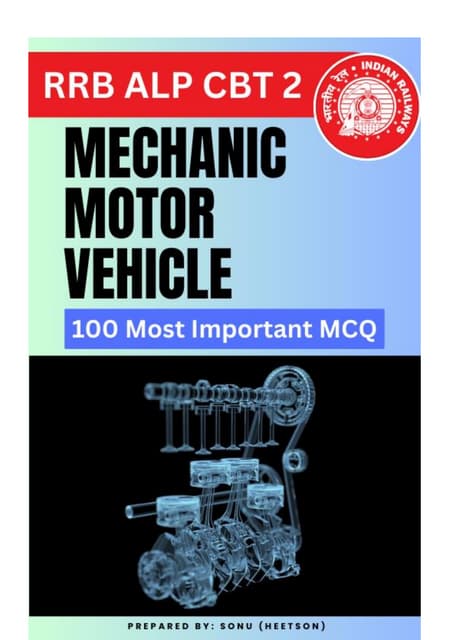



RRB ALP CBT 2 Mechanic Motor Vehicle Question Paper (MMV Exam MCQ)SONU HEETSON
╠²
RRB ALP CBT 2 Mechanic Motor Vehicle Question Paper. MMV MCQ PDF Free Download for Railway Assistant Loco Pilot Exam.BISNIS BERKAH BERANGKAT KE MEKKAH ISTIKMAL SYARIAH



BISNIS BERKAH BERANGKAT KE MEKKAH ISTIKMAL SYARIAHcoacharyasetiyaki
╠²
BISNIS BERKAH BERANGKAT KE MEKKAH ISTIKMAL SYARIAHBß╗ś TEST KIß╗éM TRA GIß╗«A K├ī 2 - TIß║ŠNG ANH 10,11,12 - CHUß║©N FORM 2025 - GLOBAL SU...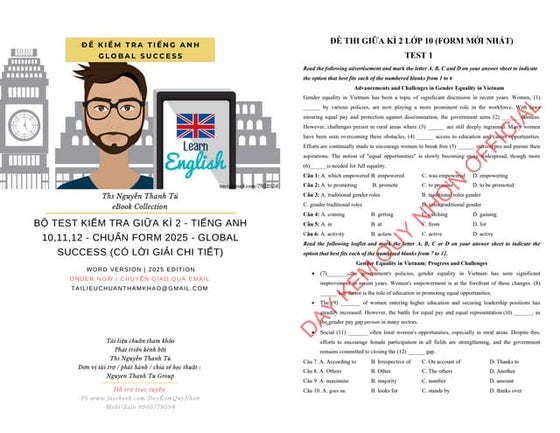



Bß╗ś TEST KIß╗éM TRA GIß╗«A K├ī 2 - TIß║ŠNG ANH 10,11,12 - CHUß║©N FORM 2025 - GLOBAL SU...Nguyen Thanh Tu Collection
╠²
https://app.box.com/s/ij1ty3vm7el9i4qfrr41o756xycbahmgHelping Autistic Girls Shine Webinar ║▌║▌▀Żs



Helping Autistic Girls Shine Webinar ║▌║▌▀ŻsPooky Knightsmith
╠²
For more information about my speaking and training work, visit: https://www.pookyknightsmith.com/speaking/How to Configure Deliver Content by Email in Odoo 18 Sales



How to Configure Deliver Content by Email in Odoo 18 SalesCeline George
╠²
In this slide, weŌĆÖll discuss on how to configure proforma invoice in Odoo 18 Sales module. A proforma invoice is a preliminary invoice that serves as a commercial document issued by a seller to a buyer.Dr. Ansari Khurshid Ahmed- Factors affecting Validity of a Test.pptx



Dr. Ansari Khurshid Ahmed- Factors affecting Validity of a Test.pptxKhurshid Ahmed Ansari
╠²
Validity is an important characteristic of a test. A test having low validity is of little use. Validity is the accuracy with which a test measures whatever it is supposed to measure. Validity can be low, moderate or high. There are many factors which affect the validity of a test. If these factors are controlled, then the validity of the test can be maintained to a high level. In the power point presentation, factors affecting validity are discussed with the help of concrete examples.Year 10 The Senior Phase Session 3 Term 1.pptx



Year 10 The Senior Phase Session 3 Term 1.pptxmansk2
╠²
Year 10 The Senior Phase Session 3 Term 1.pptxOral exam Kenneth Bech - What is the meaning of strategic fit?



Oral exam Kenneth Bech - What is the meaning of strategic fit?MIPLM
╠²
Presentation of the CEIPI DU IPBA oral exam of Kenneth Bech - What is the meaning of strategic fit? Effective Product Variant Management in Odoo 18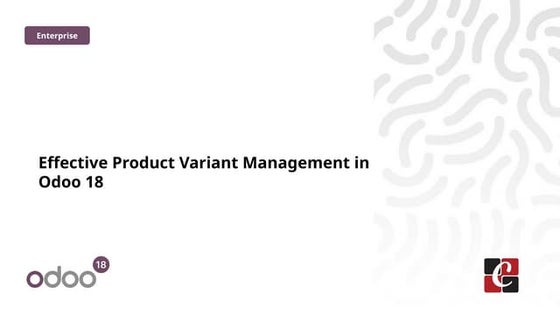



Effective Product Variant Management in Odoo 18Celine George
╠²
In this slide weŌĆÖll discuss on the effective product variant management in Odoo 18. Odoo concentrates on managing product variations and offers a distinct area for doing so. Product variants provide unique characteristics like size and color to single products, which can be managed at the product template level for all attributes and variants or at the variant level for individual variants.How to Configure Proforma Invoice in Odoo 18 Sales



How to Configure Proforma Invoice in Odoo 18 SalesCeline George
╠²
In this slide, weŌĆÖll discuss on how to configure proforma invoice in Odoo 18 Sales module. A proforma invoice is a preliminary invoice that serves as a commercial document issued by a seller to a buyer.Azure Data Engineer Interview Questions By ScholarHat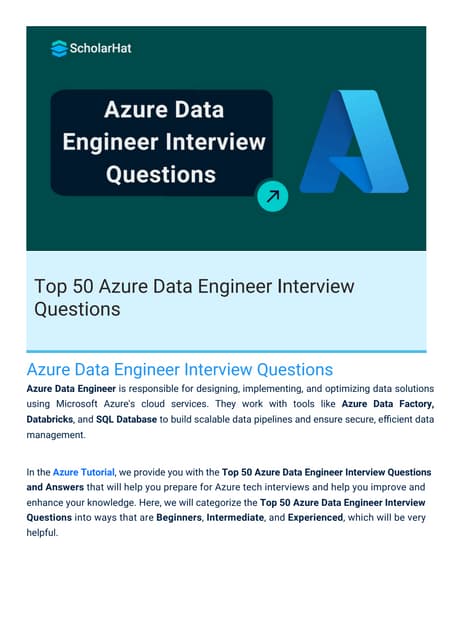



Azure Data Engineer Interview Questions By ScholarHatScholarhat
╠²
Azure Data Engineer Interview Questions By ScholarHatBß╗ś TEST KIß╗éM TRA GIß╗«A K├ī 2 - TIß║ŠNG ANH 10,11,12 - CHUß║©N FORM 2025 - GLOBAL SU...



Bß╗ś TEST KIß╗éM TRA GIß╗«A K├ī 2 - TIß║ŠNG ANH 10,11,12 - CHUß║©N FORM 2025 - GLOBAL SU...Nguyen Thanh Tu Collection
╠²
Teaching in the age of disaster slides
- 1. T E A C H I N G IN THE AGE OF DISASTER Designing Liberal Arts Education for InclusivityŌĆöand Survival
- 3. ŌĆó We need to be graduating creative, courageous, resourceful, and resilient humans. ŌĆó We need to welcome all perspectives, all voices, all bodies. ŌĆó We still think too narrowly about student identity. ŌĆó We have a white supremacy problem. My argument, part 1:
- 4. ŌĆó We need to address these white supremacies in every unit and at every level of the institution. ŌĆó Teaching in the Age of Disaster requires us to at once reinvest deeply in the liberal arts and rethink their connections to knowledge, skills, and vocation. My argument, part 2:
- 5. ŌĆó inclusion and exclusion on campus ŌĆó investment in white supremacist thinking (and other forms of discrimination) ŌĆó strategies for inclusivity ŌĆó useful philosophy: maker competencies A road map for this talk
- 6. In the 1990s, one institution alienated me by excluding others.
- 12. So I left.
- 17. Wait. . .wasnŌĆÖt this talk supposed to be about teaching?
- 19. One approach: maker competencies
- 20. Identify the need to invent, design, fabricate, build, repurpose, repair, or create a new derivative of some ŌĆ£thingŌĆØ in order to express an idea or emotion, to solve a problem, and/or teach a concept.
- 21. ŌĆó Assess the availability and appropriateness of tools and materials. ŌĆó Produce prototypes using itera:ve design principles. ŌĆó Collaborate e’¼Ćec:vely. ŌĆó Translate technical or disciplinary jargon so that itŌĆÖs useful to laypeople. ŌĆó Connect those seeking to learn something with those who have relevant experience. ŌĆó Be mindful of the spectrum of cultural, economic, environmental, and social issues surrounding making. ŌĆó Weigh the costs & bene’¼üts of seeking intellectual property protec:ons vs. making project outputs open and freely available to others.
- 22. Find student projects at http://inhershoes.idahohistory.org/
- 23. LetŌĆÖs review.
- 24. Questions? Additional relevant resources: http://bit.ly/teaching-age-of-disaster Leslie Madsen Director, IDEA Shop and Associate Professor of History Boise State University lmadsen@boisestate.edu Twitter: @lesliemb




